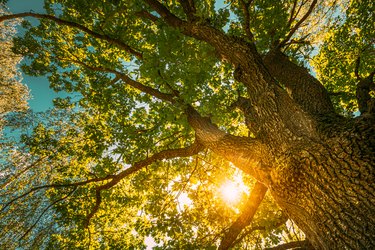
Oak trees (Quercus spp.) are susceptible to several diseases and pests that can cause the tree to begin to die from the top down. Brown leaves on an oak tree in the summertime is usually one indication that the tree is diseased. Other dying oak tree symptoms include leaf drop and branch dieback. Some species of oak may be more vulnerable to certain diseases than others.
Oak Wilt Disease
Video of the Day
One of the most concerning oak diseases, known as oak wilt, starts off with wilting and browning leaves at the top of the tree. This disease is caused by the fungus Bretziella fagacearum, which affects the plant tissues responsible for transporting water. The fungus is most active in spring and early summer and enters the tree through wounds, so avoiding pruning or injury to an oak tree during this time is critical. This disease is fatal, and there is little that can be done to help a dying oak tree.
Video of the Day
Oak tree wilt not only affects one tree but also spreads through the roots to adjacent trees. Of the two groups of oak trees – red and white – red oaks are more susceptible to oak wilt. Red oaks can be identified by their leaves, which have pointy ends, compared to the round tips of white oak leaves.
A different fungal disease known as anthracnose can cause similar symptoms to that of oak wilt, such as leaf wilting and leaf drop. However, while the symptoms of oak wilt are usually first observed at the top of the tree, anthracnose tends to begin on the lower leaves and branches.
Brown Leaves on Oak Trees
If you notice oak tree leaves turning brown in the summer before the normal change of color that occurs in the fall with deciduous trees, bacterial leaf scorch may be to blame. This condition can be caused by a lack of water or by fungal or bacterial infections that attack the water-conducting tissues. The bacteria species Xylella fastidiosa, which is often transmitted by spittle bugs and leafhoppers, may be involved. The leaves of an infected oak tree will start to brown along the edges, usually beginning with the older leaves. Over time, bacterial leaf scorch can kill a tree.
Oak Tree Pests
One of the most serious pests of oak trees is the two-lined chestnut borer, which attacks a wide variety of oak trees. These insects lay their eggs in crevices in the bark of the oak tree, and the larvae that emerge from the eggs feed on plant tissue. Their feeding can destroy the tissues that transport water and nutrients within the tree, which results in wilted leaves and branch dieback.
In large numbers, two-lined chestnut borers can kill an oak tree over time, though not as quickly as oak wilt does. Preventing borer infestations is preferable to attempting to treat them. Two-lined chestnut borers tend to attack trees that are weakened or stressed, so keeping the tree well-watered and preventing injuries to the bark can help keep them at bay.
- Michigan State University Extension: Oak Wilt Disease
- University of Minnesota Extension: Oak Wilt in Minnesota
- Missouri Botanical Garden: Oak Wilt
- PennState Extension: Bacterial Leaf Scorch
- University of Illinois Extension: Bacterial Leaf Scorch of Oak
- University of Wisconsin-Madison Horticulture Division of Extension: Two-Lined Chestnut Borer